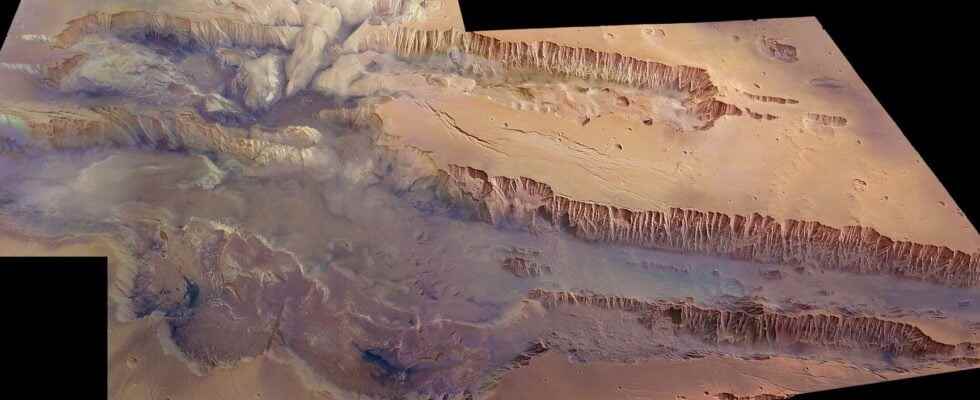There should be no water on the surface of Mars at the equator, and very little there just below that surface. And yet the instruments of the Exomars mission say the opposite in certain parts of the famous giant canyon of the Red Planet: Valles Marineris.
As we know, the question of the presence of water on Mars, now or in its past, is crucial as well for theexobiology than for the colonization of the Red Planet. We are also trying to determine nowadays where there are deposits ice and if possible water liquid to send settlers and exobiologists there. In the latter case, perhaps in areas still volcanically active and therefore sources of heat maintaining water in a liquid state, we can think that we would have a better chance of discovering living Martian organisms.
What is certain is that on the surface of Mars, the presence of ice is conditioned to temperatures and pressures, so that normally, we do not expect to find it at theequator because it is generally too hot there. Ice on the surface would sublimate quickly. But it could be present in depth. It is therefore with a certain surprise that we learn via an article published in the newspaper Icarus that there should be significant amounts of water, perhaps in the form of ice, but really just below the surface of the famous Martian Grand Canyon: Valles Marineris.
Layers made up of 40% water?
This is the conclusion reached by a team of planetologists studying the data by the joint mission of ESA and Roscomos, namely ExoMars Trace Gas Orbiter. These data were more precisely provided by the Frend instrument (Fine Resolution Epithermal Neutron Detector) which allows to determine the content in hydrogen, and therefore in water, of the superficial layers of Mars about one meter thick.
Igor Mitrofanov, from the Space Research Institute of the Russian Academy of Sciences in Moscow, lead author of the new study and lead researcher of the neutron detector, explains in a press release from theESO that ” with TGO, we can look up to a meter below the dusty layers and see what is really going on beneath the surface of Mars – and, most importantly, locate water-rich “oases” that could not be detected with previous instruments “And he adds that” Frend revealed an area with an unusually high amount of hydrogen in the colossal canyon system of Valles Marineris : assuming the hydrogen we see is bound to water molecules, up to 40% of the matter near the surface in this region appears to be water “.
His Russian colleague and co-author Alexey Malakhov, also from the Space Research Institute of the Russian Academy of Sciences, explains that: “ Frend’s unique observation technique provides resolution much higher spatial than previous measurements of this type, now allowing us to see structures with water that had not been spotted before. We determined that a central part of Valles Marineris was full of water – much more than we expected. It looks a lot like the regions of permafrost Earth, where water ice permanently persists under dry soil due to constant low temperatures. “
Water that blocks the flow of cosmic neutrons
We also learn in the press release that the water-rich area is roughly the size of the Netherlands and straddles the deep valleys of Candor Chasma.
But how can we detect the presence of water with a flux of neutrons and in addition from an instrument in orbit ?
As shown in the series of diagrams above, the bombardment of cosmic rays causes in reaction theepisode neutrons by atoms from the surface of Mars, for example under a Martian crater.
However, the hydrogen atoms act as a sort of filter for the flow of neutrons from the upper layers of the surface of Mars and caused by these cosmic rays. Remarkably, it is possible to use the measurements of the characteristics of this flow, more precisely its decrease in intensity, to deduce not only the presence of a layer of ice or of organic molecules rich in hydrogen atoms, but also the thickness of these layers.
The presence of water seems acquired but even if the researchers believe that the water is in the form of ice, it is possible that it is also, partially or totally in the form of minerals hydrated.
In any case, it is a little paradoxical because this water is very close to the surface, where it cannot exist, which suggests mechanisms which remain to be elucidated in order to understand its presence. The layer could thus be constantly replenished with water.
Interested in what you just read?
.
fs3
